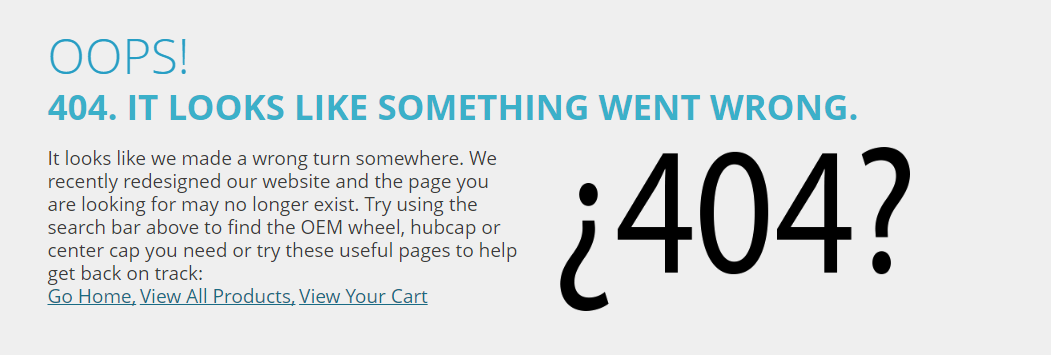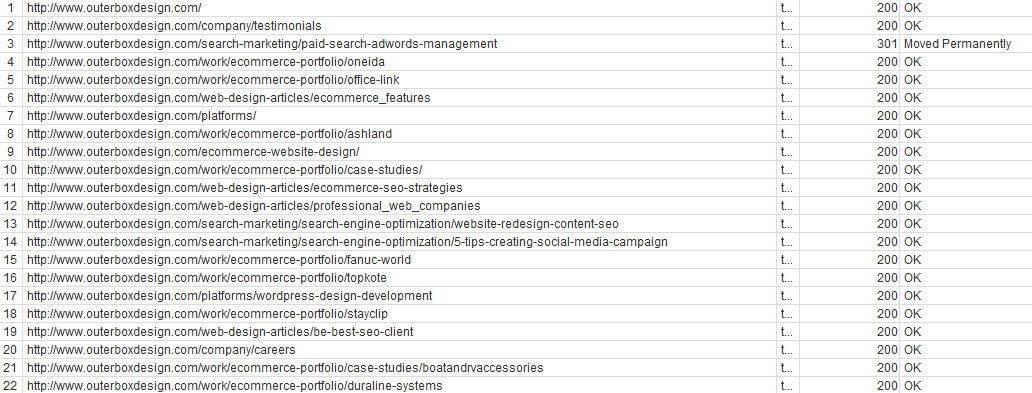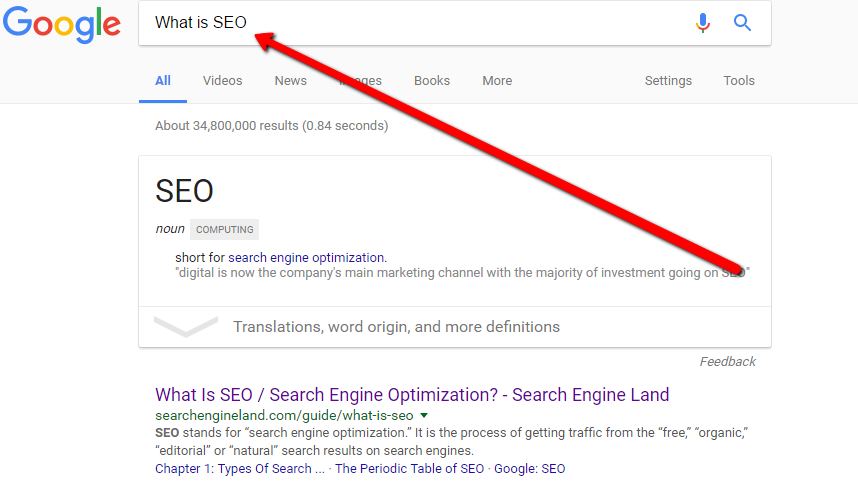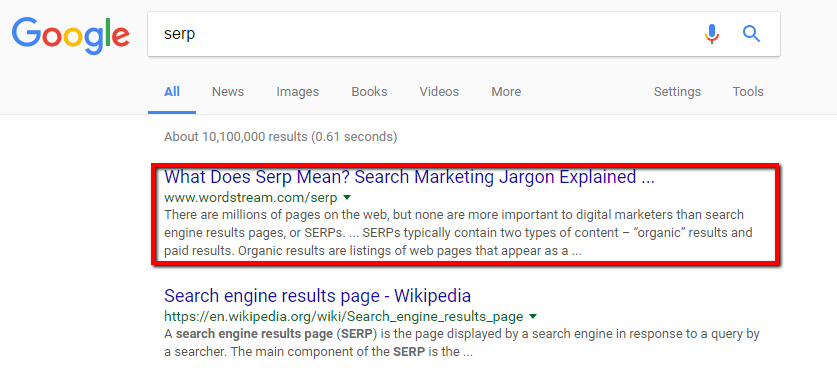Terms and concepts used in SEO
SEO Terminology: A Glossary of the Most Popular SEO Terms
Search engine optimization can sound much like a foreign language, especially if it’s a new concept for you. Suppose you’re considering hiring a digital marketing agency to help with optimization. In that case, you’ll need to know some basic SEO terminology to stay in the loop about the ins and outs of your site.
Need help with your SEO strategy? Call us at 1-866-647-9218 or click “Get a Free Quote” at the top of your screen.
301 Redirect or Redirection
A page that, when visited, immediately sends users to a different page on a site. 301s are put in place when a web page is deleted or does not exist. 301’s are beneficial for pages linked to other sites or ranking on search engines. It helps keep your site’s user experience intact and ranking pages in good standing with search engines.
404 Not Found
A 404 not found error occurs when a user tries to access a page that does not or no longer exists. Often, when a 301 redirect hasn’t been put in place on a page that does not exist, users may see something like this:

Algorithm
A sequence of actions performed, including calculations and automated reasoning. For SEO, we referred to Google’s algorithm that automates organic search results factoring in over 300 different signals.
Alt Text/Tag
An SEO element for describing images to search engines. Because search engine bots cannot see photos, the ALT tag helps with a string of words about the picture, often including an important keyword.
Analytics
A system for computing and analyzing a set of data or statistics. For SEO, we use analytical statistics like website traffic, users, revenue, traffic sources, site goals, and the behavior pattern of users to compare the progress of an SEO campaign. Google Analytics is a standard software for collecting and reporting analytical data.

Anchor Text
Text within a clickable website links to another page on the site or a different domain. This text is typically a different color than the other text to indicate a hyperlink. For SEO, anchor text links a relevant keyword to its corresponding page.
Black Hat SEO
SEO is an aggressive strategy that does not adhere to search engine policy and guidelines. Black hat SEO can refer to hiding text on a website, keyword stuffing, spam link building, content automation, cloaking, and several others. Black Hat SEO can penalize a site from search engines, preventing it from ranking organically.
Branded Keywords
A set of organic or paid keywords that include the brand or name of a business.
Canonical Tag
HTML markup placed on a web page that is not considered an authority page. A canonical tag tells search engines to look at the URL specified in the title as the authority and preferred version of the page, passing link juice and rankings to that URL.
Click Through Rate/CTR
The rate at which users click on a website from organic or paid search results. CTR is a way to gauge title and description performance.
Content Management System/CMS
An application used to manage digital content in a collaborative environment. Popular content management systems include WordPress, Onveos, and Magento.
Conversion
A conversion occurs when a user completes the most important action on a website. Activities can include buying a product, signing up for a newsletter, filling out a contact form, registering for a webinar, etc.
Crawl
I use a third-party application to search a website and collect data, including pages, status codes (200, 301, 404), and SEO elements like titles and meta descriptions.

CSS
Cascading Style Sheets is a language for how the HTML markup on a site will look.
Dead Link
A hyperlink that is broken and directed to a page that no longer exists. Errors like 404 not found, server errors, 500 errors, 403 forbidden, etc. Dead links can hurt SEO.
Disavow
A process of identifying spam backlinks to a site and telling search engines to ignore them. The disavow tool was implemented to help areas with a weak or poor backlink profile recover from penalties and avoid multiple links from one or more spammy websites.
Duplicate Content
An SEO term for a block of content that is present on more than one page or website on the internet. It is considered a wrong signal for SEO and can result in a search engine penalty. See canonical tags for a solution for duplicate content within the same domain.
eCommerce SEO
An SEO campaign or search engine optimization tactic is performed to increase rankings specifically for an eCommerce brand, category page, or product page. Often an eCommerce SEO campaign focuses on product name or product SKU keywords.
Dynamic Tags
Various SEO page elements are automatically generated using placeholder tokens to quickly put passable meta tags on all site pages. These give page pages different titles, meta descriptions, and other SEO elements unique for search engines.
Fresh Content
A website that is continually updated (weekly or monthly) with content that can include a blog, resource center, and updated metadata.
FTP
File Transfer Protocol transfers files to and from a computer, network, or website.
GoogleBot
Also known as a spider, a web crawler that discovers and indexes new and updated pages on a site.
Google Analytics
An online analytics software and service that collects and reports on web traffic, allowing marketers to track the progress of conversions, revenue, traffic sources, and paid campaigns to a website.
Google Search Console
She was formerly known as Google Webmaster Tools. Google provides a free service to monitor a website’s index and crawl status.
H1
Also known as a heading, the H1 is typically the most significant page text and the primary thought. For blogs, this is often the name of the blog post. It can be similar to the title but not the same to maximize SEO efforts.
HTML
Hypertext Markup Language. The system for creating and marking up websites with content, graphics, links, and images.
Inbound Link
Links from other websites that direct users to a page on your website. Inbound links are also known as a backlink.
Internal Link
A hyperlink of text or an image within a website that links to another page on the same site. This is an excellent opportunity for SEO to incorporate relevant keyword-driven anchor text.
IP Address
A unique set of numbers is usually separated by periods that devices, including computers, smartphones, and tablets, use to communicate on the same network. An IP address is a digital footprint for internet activity on the web.
Keyword Not Provided
When looking in Google Analytics under organic keywords, “keyword not provided” are organic searches for users logged into their Google account that is no longer accessible for data collection.
Keyword Research
During an SEO campaign, research on competitors and a site’s current rankings help develop a list of keywords to target for on-page optimization, content development, and link building.
Keyword Stuffing
A black hat SEO tactic for adding a significant amount of a keyword onto a page or website to manipulate organic search engines.
Landing Page
A page on a website that is specific and unique to a group of users. For SEO, a landing page targets a particular keyword and typically has an excellent call to action for users to perform.
Link Building
The practice of gaining links from other websites to improve a site’s authority. Typical link building includes local citation building, blogger outreach, forums, etc.
Manual Penalty
The negative impact on a site is based on a search engine’s algorithm. A penalty can happen when black hat SEO tactics are employed.
Meta Description
HTML markup allows users to see a snippet of a web page that is typically 160 characters long. This description displays in organic search results for Google, Bing, Yahoo, etc.
Nofollow
HTML markup on a link tells search engines not to pass link juice and authority to the site it’s being linked to. Nofollow links are standard practice for sites that outbound link regularly.
Organic Search Results
Results on a search engine are based on the relevance of the keyword a user is searching. These are typically displayed after paid advertisement at the top of the page.
Outbound Link
Links within a website that take users to another website.
PageRank
Created by Google and that ranks both the quality and quantity of links to a site that will help determine a domain’s authority. This scale is 0-10, with 10 being the highest authority.
Panda
First released by Google in 2011, Panda is an algorithm update for how Google shows organic search results. This update is aimed at thin content sites and low-quality sites to improve user results.
Penguin
In 2012, Google’s Penguin algorithm updated and launched and targeted unnatural link building to boost and manipulate a website’s organic rankings.
Quality Content
Content that is relevant and robust for users based on the keyword, industry, and website. Quality content also means writing for users and not just for SEO.
Quality Link
The creation of relevant and natural links to a website. Typically, having high-quality links to a site can result in improved PageRank, domain authority, and organic rankings.
Robots.txt File
A text file on a website that instructs search engines to ignore certain parts of the site. These are created to prevent search engines from crawling pages like the admin, logins, cart pages, etc.
Search Engine
An SEO term is a program that searches millions of pages and documents using an algorithm to display the most relevant and quality results based on a user’s search query.
Search Query
A keyword a user types into a search engine to find relevant websites and information.

SEM
Also known as Search Engine Marketing, SEM is digital marketing across organic and paid advertising platforms to increase a website’s or web page’s visibility.
SEO
Also known as Search Engine Optimization, SEO is the digital marketing practice for increasing free traffic and visibility to a website or web page through search engine rankings. SEO practices typically include on-page optimization, content development focusing on particular keywords, and high-quality link building.
SERP
Pages displayed by a search engine based on the keyword of a user. Typically, the title and meta description are present for the user, giving them relevant information about the website before clicking.

Sitemap
A list of pages on a website that is easily accessible to search engines, crawlers, and users. Typically, sitemaps are formatted as an XML file and organized as a hierarchy. Sitemaps are beneficial for indexing new and updated web pages.

Title Tag
The HTML elements on a web page represent the most relevant keyword and information about the page. The title tag displays to users at the top of their browser and in search engine results. The title tag is one of the most critical factors when rankings a web page for a particular keyword.
URL
A web address that points to a unique page on a website, FTP, email, or database access. Also known as a Uniform Resource Locator.
Usability
Usability is an SEO term based on user-centered design. When developing a site, the design, development, and SEO are created based on how the user will interact with the website to improve their experience.
White Hat SEO
Search engine optimization techniques are aligned with best practices and are user-focused to improve a website’s organic visibility, also known as ethical SEO.











